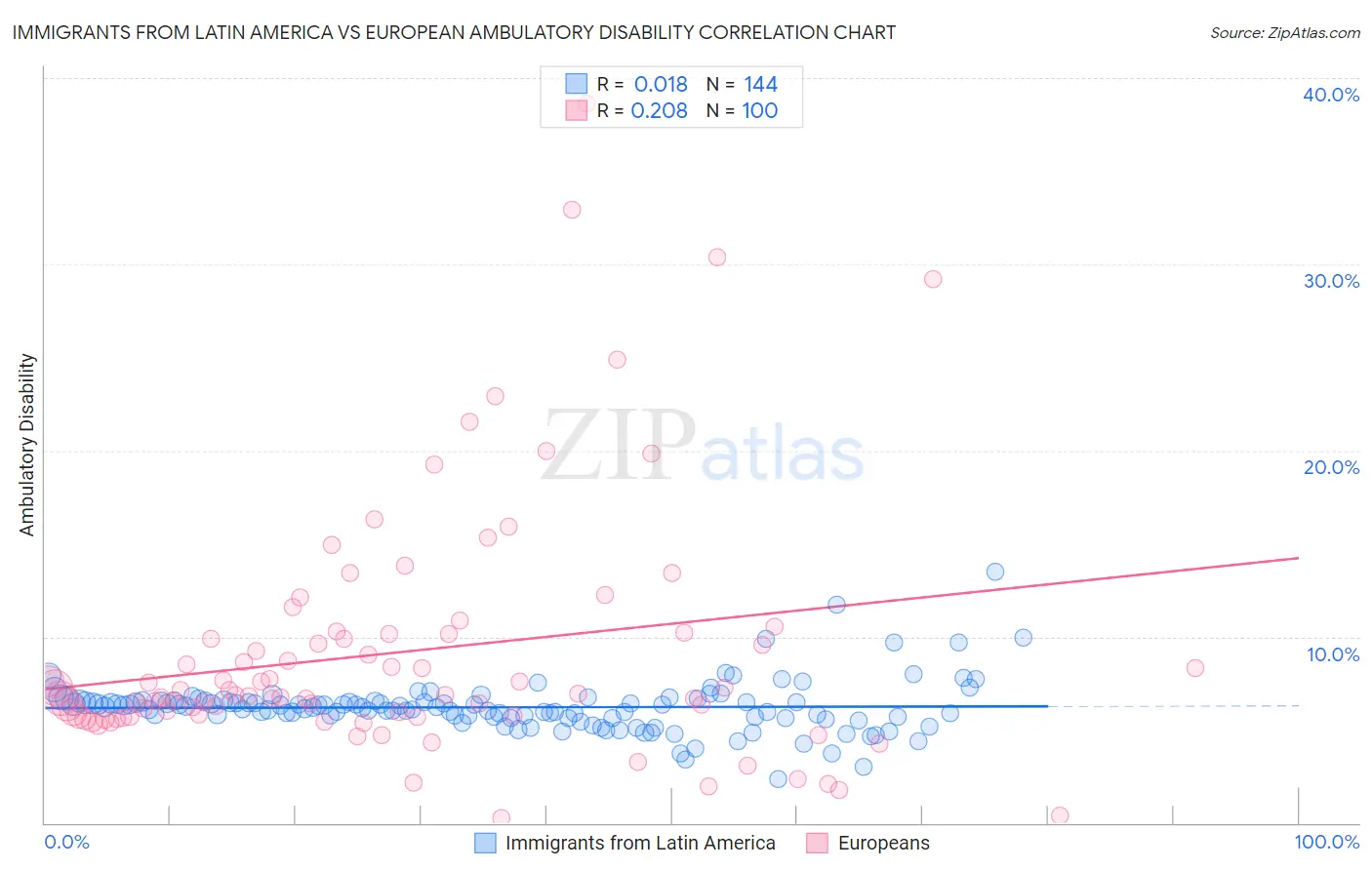Immigrants from Latin America vs European Ambulatory Disability
COMPARE
Immigrants from Latin America
European
Ambulatory Disability
Ambulatory Disability Comparison
Immigrants from Latin America
Europeans
6.3%
AMBULATORY DISABILITY
11.0/ 100
METRIC RATING
215th/ 347
METRIC RANK
6.2%
AMBULATORY DISABILITY
36.2/ 100
METRIC RATING
186th/ 347
METRIC RANK
Immigrants from Latin America vs European Ambulatory Disability Correlation Chart
The statistical analysis conducted on geographies consisting of 558,117,601 people shows no correlation between the proportion of Immigrants from Latin America and percentage of population with ambulatory disability in the United States with a correlation coefficient (R) of 0.018 and weighted average of 6.3%. Similarly, the statistical analysis conducted on geographies consisting of 561,341,631 people shows a weak positive correlation between the proportion of Europeans and percentage of population with ambulatory disability in the United States with a correlation coefficient (R) of 0.208 and weighted average of 6.2%, a difference of 2.0%.

Ambulatory Disability Correlation Summary
| Measurement | Immigrants from Latin America | European |
| Minimum | 2.4% | 0.26% |
| Maximum | 13.5% | 38.6% |
| Range | 11.1% | 38.4% |
| Mean | 6.2% | 9.2% |
| Median | 6.2% | 6.9% |
| Interquartile 25% (IQ1) | 5.7% | 5.7% |
| Interquartile 75% (IQ3) | 6.5% | 10.2% |
| Interquartile Range (IQR) | 0.86% | 4.5% |
| Standard Deviation (Sample) | 1.4% | 6.7% |
| Standard Deviation (Population) | 1.4% | 6.7% |
Similar Demographics by Ambulatory Disability
Demographics Similar to Immigrants from Latin America by Ambulatory Disability
In terms of ambulatory disability, the demographic groups most similar to Immigrants from Latin America are Immigrants from Mexico (6.3%, a difference of 0.010%), Canadian (6.3%, a difference of 0.010%), Yugoslavian (6.3%, a difference of 0.010%), Guamanian/Chamorro (6.3%, a difference of 0.050%), and Mexican American Indian (6.3%, a difference of 0.13%).
| Demographics | Rating | Rank | Ambulatory Disability |
| Bangladeshis | 14.2 /100 | #208 | Poor 6.3% |
| Immigrants | Iraq | 14.0 /100 | #209 | Poor 6.3% |
| Immigrants | Laos | 13.2 /100 | #210 | Poor 6.3% |
| Samoans | 12.1 /100 | #211 | Poor 6.3% |
| Mexican American Indians | 12.0 /100 | #212 | Poor 6.3% |
| Japanese | 12.0 /100 | #213 | Poor 6.3% |
| Immigrants | Mexico | 11.0 /100 | #214 | Poor 6.3% |
| Immigrants | Latin America | 11.0 /100 | #215 | Poor 6.3% |
| Canadians | 10.9 /100 | #216 | Poor 6.3% |
| Yugoslavians | 10.9 /100 | #217 | Poor 6.3% |
| Guamanians/Chamorros | 10.6 /100 | #218 | Poor 6.3% |
| Indonesians | 9.9 /100 | #219 | Tragic 6.3% |
| Immigrants | Albania | 9.6 /100 | #220 | Tragic 6.3% |
| Hungarians | 9.6 /100 | #221 | Tragic 6.3% |
| German Russians | 9.4 /100 | #222 | Tragic 6.3% |
Demographics Similar to Europeans by Ambulatory Disability
In terms of ambulatory disability, the demographic groups most similar to Europeans are Carpatho Rusyn (6.2%, a difference of 0.050%), Immigrants from Bosnia and Herzegovina (6.2%, a difference of 0.060%), British (6.2%, a difference of 0.11%), Ukrainian (6.2%, a difference of 0.13%), and Immigrants from Western Africa (6.2%, a difference of 0.17%).
| Demographics | Rating | Rank | Ambulatory Disability |
| Austrians | 44.1 /100 | #179 | Average 6.1% |
| Immigrants | Nicaragua | 43.9 /100 | #180 | Average 6.1% |
| Swiss | 43.1 /100 | #181 | Average 6.1% |
| Serbians | 42.8 /100 | #182 | Average 6.1% |
| Immigrants | Thailand | 42.2 /100 | #183 | Average 6.1% |
| Immigrants | Ghana | 41.2 /100 | #184 | Average 6.1% |
| Immigrants | Bosnia and Herzegovina | 37.2 /100 | #185 | Fair 6.2% |
| Europeans | 36.2 /100 | #186 | Fair 6.2% |
| Carpatho Rusyns | 35.3 /100 | #187 | Fair 6.2% |
| British | 34.3 /100 | #188 | Fair 6.2% |
| Ukrainians | 34.0 /100 | #189 | Fair 6.2% |
| Immigrants | Western Africa | 33.4 /100 | #190 | Fair 6.2% |
| Immigrants | Guatemala | 31.9 /100 | #191 | Fair 6.2% |
| Immigrants | Western Europe | 31.6 /100 | #192 | Fair 6.2% |
| Guatemalans | 30.0 /100 | #193 | Fair 6.2% |